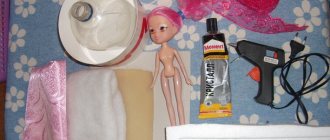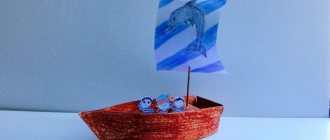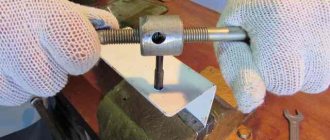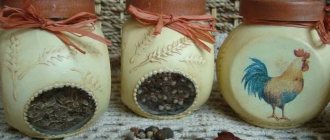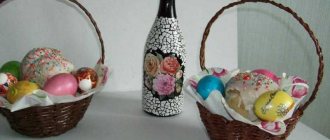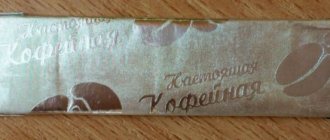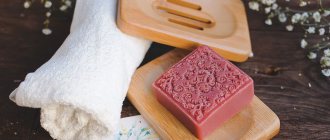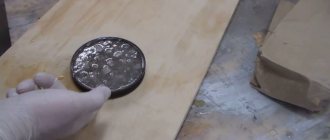Additional decorative elements significantly transform the design of each room in the house. Various boxes or boxes are used not only as an accessory, but also perform a practical function. Boxes made using the decoupage technique will look especially bright and unusual. You can use several design options, which will allow you to choose the style of the box for almost any interior design.
Currently, decoupage boxes are gaining more and more fans, which is not surprising.
Decoupage boxes in vintage style: where to start
The creative process begins with the search for the necessary materials. It’s good if you already have a box in mind that you want to decorate. If not, you should visit a craft store. Here you can always pick up an interesting thing for decoration
. You also need to choose an image that will decorate the accessory. The main rule of decoupage is that the design must be printed on the base. In theory, any picture could work, but there's a catch.
After carefully removing the image, we begin to carefully roll up the excess paper. Having removed the excess, we leave the thin cloth to dry, after which we very carefully clean the underside with fine sandpaper.
Working with rice paper also has certain nuances. First of all, you need to know that the density and, accordingly, the thickness of the sheets varies. There are thin leaves, and there are also quite thick ones. The latter are less convenient to use.
Another feature of rice canvas is the presence of fibers.
, which make it a little difficult to cut off the image. After the motif is separated from the main fabric, they must be trimmed with sharp scissors. For experienced craftswomen, all this is not difficult, but for beginners, it is best to decoupage the box with napkins or special cards. In addition to the decorative material and the box itself, you will need acrylic paints, sandpaper, acrylic varnish, glue, brushes, a foam sponge or sponge.
Crackle
Crackle
- artificial aging technique, creating cracks in the paint or varnish layer.
Craquelures are divided into one-step (single-phase) and two-step (two-phase)
One-step craquelure
looks like a cracked layer of paint, through the cracks of which the lower layer of paint or the base of the product is visible. The base can be anything: glass, metal, plastic, wood and similar materials.
Two-step craquelure
looks like a network of thin cracks (cracked varnish) on the surface of any image or coating.
2. Eggshell crackle
Gives a bright, high-relief cracking effect. A clean shell is glued onto PVA or acrylic varnish in pieces at some distance from each other. Sometimes the relief is further emphasized by patination or the “dry brush” technique.
Faceted varnish
Colored self-crack varnish. Apply a thick layer to the surface and leave to dry. Forms large cracks.
4. Two-component microcraquelure
Gives the effect of thin cracks - cobwebs. Transparent, so it is often used over images.
After drying, cracks are often emphasized by patination.
5. Craquelure paint
Self-cracking paint with a one-step craquelure effect.
More detailed article about techniques for creating craquelure
Box decoupage technique
So, having collected the necessary tools, we proceed directly to creativity. Perhaps the most ideal material for decoupage is wood. At the same time, using this technique, you can process both the tea box and the plastic surface with your own hands. Whatever material you choose, in any case, the box must be prepared first. To do this, we treat the surface of the box with sandpaper.
First, sand the wooden piece with sandpaper.
The workpiece can then be primed using acrylic primer.
Priming the workpiece with acrylic primer
It is better to remove metal elements using a screwdriver. The next stage is toning the workpiece. To do this, paint the box with acrylic paint.
The next step is to directly transfer the design to the surface of the workpiece. Such pictures for transfer can be purchased at a specialized store. To do this, we separate with our own hands the top layer of the decoupage napkin on which the design is applied. We tear out the elements of the drawing with our hands. Having placed the napkin on the desired field of the box, apply glue for decoupage.
One of the simplest ways to apply glue to a decoupage napkin
Leave until completely dry. Apply varnish on top in several layers. The next stage is decorating the box with your own hands.
Next, we decorate our work, depending on the chosen style.
First, we return all the elements removed at the first stage of work. Decorating the box depends solely on the style chosen for decoupage. In addition, the product can be refined using the craquelure technique.
The final stage is to coat the entire work with varnish.
To better understand the sequence of actions, watch the video at the end of the article.
Brushing
The most common method of mechanical aging of wood is brushing. Its name comes from the word Brush - “brush”.
The surface is treated with metal brushes, selecting the top soft fibers, leaving only the hard ones.
An ideal way to age if the furniture is made from:
• pine trees
• larch
• oak
• ash
This method will not work if the furniture is made of:
• teak
• maple
• cherries
• beech
• pears
Brushing wood with firing or smoking
It is performed using either an open fire, or, which is much more convenient, using a blowtorch or gas torch. By directing the flame onto the surface of the wood, you can achieve different shades of wood - from light golden to black. The color depends on the initial color of the wood and the number of fire passes. Then brushing is performed - treating the surface of the wood with a stiff wire brush. In this case, the softer, burnt parts of the wood are cleaned out, and the harder ones (annual rings) remain in place.
Another way is firing in hot sand.
Fine, clean sand is poured into a metal container and heated to a temperature not exceeding 200 degrees C. Place the products prepared for firing into the hot sand and keep there until they darken. If the tone of individual parts of the product should lighten gradually, then these parts are immersed vertically in sand. The lower layers of sand heat up more than the upper ones, so the lower part of the piece will be darker than the upper. Thus, the result is a tone that goes from light yellow to dark brown. The surface treated with brushes and fire can be tinted using the glaze or dry brush method, images can be added using the decoupage technique, or color can be added by spraying.
Vintage suitcase
If you are lucky enough to keep an old suitcase intact, then decoupage it with your own hands, using a napkin, in vintage style. This master class for beginners will clearly show how to do this.
Here are the accessories that will be needed in such a work process as suitcase decoupage:
- suitcase;
- napkins with a matching motif;
- glue;
- file;
- acrylic paints;
- acrylic varnish;
- candle;
- brush and roller;
- washcloth and sandpaper.
Clean the surfaces of the corners and repair the handle, and then degrease the suitcase with alcohol and leave it to dry.
Rub all the edges of the suitcase with a candle stub, and then paint it with beige acrylic paint several times, allowing time to dry between jobs, as shown in the photo.
In order to get the antique effect, use sandpaper to go over all the edges, as shown in the photo, and remove the paint. Choose vintage style napkins and peel off the top layer. Place them on a surface coated with glue and go over them with a roller.
The most central design of the napkin is placed on the file, and water is poured on top. Then it is leveled with a brush and applied to the suitcase. Remove the file, holding the corner of the napkin, and cover the design with glue. Let the product dry.
The final touch is coating the suitcase with acrylic varnish and decoupage of the suitcase is completed. The master class in vintage style is completed, and such a musical suitcase will serve you for many more years.
Aging a printout
Well, finally we start decoupage.
Here we used this cute picture with illustrations from the book “Alice in Wonderland”. The picture, as always, is made from office paper, printed on CISS with pigment ink.
To age it well, we had to spoil it from the heart. They crumpled it into a ball, unfolded it, and crumpled it again. Unroll it and throw it into the water to soak.
For the best antique effect, add strongly brewed black tea or a tea bag to the water. It will tint the printout slightly yellow, and the creases caused by creasing the paper will appear darker.
There is no need to keep the picture in the water for a long time; after 3-4 minutes we take it out and glue it onto the “book cover” using a file. We tear it in the same way as we would tear a sheet of clay.
Let it dry and everything can be coated with acrylic varnish.
Decoupage in Provence style
Another fashionable technique is decoupage in Provence style.
Handmade box in delicate Provence style
Popular articles Valentine card with 3D heart
To implement it, it is necessary to carry out the same sequence of actions. However, the Provence style involves the following nuances:
- using pictures of flowers as drawings;
- turning to pastel shades;
The peculiarity of the Provence style is floral motifs and pastel colors
Provence style is perfect for a round box. To transfer to the surface, it is better to use pictures with rustic motifs. It will be interesting to look at decoupage in the Provence style in combination with the craquelure technique. The craquelure style is characterized by the appearance of cracking of the picture.
Box in Provence style, made in lilac color
Additional mechanical impact
Sometimes time comes in the form of a wood-boring beetle. To imitate such damage left by an insect, craftsmen use an awl, a drill, and even a laser. In the same way, minor damage is caused - chips or abrasions similar to those that surfaces receive over decades.
Another way to cause noble damage is to put nuts and bolts in a rag and beat the object with this bag. And then artistically refine it to the desired result.
Imitation of past decades, aging techniques and techniques combined with chemical and mechanical processing, give excellent decorative results.
For practical decoration, acrylic-based compositions deservedly occupy a large part in the arsenal of materials. They are convenient to use: almost odorless, diluted with water, and easily washed off from tools. They have a variety of effects (imitation metals, oil paints, matte tempera) and different textures. The color scheme can inspire a remodel, even if it was not started. They are durable, resistant to water and sunlight. Sebilkova Anna
Decoupage boxes in patchwork style
Patchwork is a very unusual handicraft that involves making both small and large crafts from scraps of fabric. Fabric decoupage of the box is a very bold and successful solution.
Patchwork is a very unusual handicraft
What is necessary:
- wooden box;
- lace;
- linen fabric;
- padding polyester;
- lock;
- glue;
- paints;
- tassels;
- varnish;
- texture paste;
- stencil;
- palette knife;
- sandpaper;
- masking tape;
- a thread;
- needle.
Progress:
- Clean the workpiece using sandpaper.
- Cover the fabric with white paint, leaving only the edges unpainted.
- Cut out squares from a napkin and remove all the lower layers from these parts.
- Attach these elements to the fabric and coat with glue.
- Lay padding polyester on the inside of the fabric, then fold the edges.
- Secure the structure in this position using masking tape.
- Pull the edges onto the cardboard using a needle and thread.
- Fix the workpiece on the lid of a wooden box.
- Apply structural paste to the side elements using stencils and a palette knife.
- Dry the work and be sure to varnish it.
Wooden box decor in shabby chic style
This work is so simple that even for novice needlewomen its implementation will not be difficult. There are only a few stages of work and several of its characteristic features that can be mastered fairly quickly. You just need to follow the instructions.
Progress:
- Carefully unscrew and remove absolutely all fittings from the workpiece.
- Mix dark paint with water. The consistency of the mixture should resemble low-fat kefir.
- Paint the structure with the prepared paint and wait until it dries.
- Use sandpaper to sand the outer part of the product.
- Rub the edges generously with wax.
- Now mix white paint with water and completely paint over the wooden box.
- After the white paint has dried, go over the corners with sandpaper so that the dark color begins to show in these places.
- Choose a suitable design on a napkin and cut out this motif.
- Layer this picture and use only the topmost layer in your work.
- Glue the napkins using water.
Decoupage in shabby chic style
Shabby chic in its idea is somewhat reminiscent of both Provence and vintage styles.
Romantic types will especially appreciate this box in the shabby chic style.
You could even say that vintage is an integral part of shabby chic. Translated, this phrase means “shabby chic.”
Character traits:
- light pastel colors;
- floral motifs of pictures;
One of the features of the shabby chic style is floral motifs.
- elements reminiscent of old grandmother’s things;
- lack of clear lines and geometric patterns;
- the use of pastoral motifs as an ornament, which makes shabby chic similar to the “rococo” style;
- the use of tea roses and angels as decorative elements; stylistic uniformity – a couple of decorative details in the shabby chic style are not enough
- a large number of delicate details.
Shabby chic style combines a large number of details
Set of boxes in shabby chic style
Using decoupage and craquelure techniques, you can decorate the box in any style; it will be especially interesting to do this for the holiday. Thus, New Year's boxes using the decoupage technique are very popular. A book will look interesting using this technique. Or you can use a book-shaped box for creativity.
Stylish box made using decoupage and shabby chic techniques
We hope that the presented ideas and videos helped you understand the decoupage box technique.
The effect of different stains on different types of wood
| Copper sulfate, 1% | Iron sulfate, 4-5% | Iron sulfate, 1% | Zinc sulfate, 2.5% | Potassium chromium, 3% | Potassium chromium, 5% | ||
| Oak, willow | Brown | Blue-black | Lilac gray | Red-brown | Light brown | Dark brown | |
| Nut | Brown | Blue-black | Lilac gray | Red-brown | Brown | Dark brown | |
| Beech | — | Black | Lilac gray | Red-brown | Light brown | Dark brown | |
| Maple | — | Dark grey | Light lilac gray | — | Yellow-brown | Yellowish-golden | |
| Birch | — | Dark grey | Light lilac gray | Dark red | Greenish yellow | Yellowish-golden | |
| Aspen | — | Dark silver gray | Silver gray | — | — | — | |
| Linden | — | Light brown | Pink | Dark red | — | — | |
| Red tree | — | Black | Grey-violet | — | Reddish brown dark | Dark brown | |
| Manganese sulfate, 2.5% | Calcium chloride, 1% | Epsom salt, 2% | Ferric chloride, 1% | Copper chloride, 1% | Potassium chromium and iron sulfate (1.5% each) | ||
| Oak, willow | Dark brown | Red-brown | Brown | Slate gray | Light brown | Olive brown | |
| Nut | Dark brown | Red-brown | Brown | Dark blue | Darkening | — | |
| Beech | Dark brown | Red-brown | Brown | Grey | — | Olive brown | |
| Maple | — | — | — | Taupe | — | — | |
| Birch | Brown | Coffee | Violet | — | — | Olive | |
| Aspen | — | — | — | — | — | — | |
| Linden | Brown | Coffee | Violet | — | — | — | |
| Red tree | — | — | — | Grey-violet | Darkening | — | |
Vintage wooden box
To carry out work using the decoupage technique, you will need material that can be easily purchased in a specialized store, namely:
- dark-colored wooden box blank;
- priming;
- glue, scissors, brush and washcloth;
- napkin or decoupage card;
- white lace;
- acrylic paints;
- 3D varnish;
- acrylic lacquer.
After you have prepared everything, you can conduct a master class and decoupage the box. First of all, you need to measure the size of the card or napkin and fit it to the box. Pour PVA glue into a small container, then dip the brush into it and begin to coat the entire surface of the box with it. Attach the image to the lid of the box and immediately apply glue on top of the image. Don't be alarmed if white streaks of glue remain; PVA, after drying, becomes transparent. Glue the card or napkin using gentle movements to avoid the formation of folds and air bubbles. If they have already formed, lift the image and apply glue again. The lid of the box is left until completely dry. The next stage of work moves to the bottom of the box. This plane of the box, using decoupage technique, will be decorated with white lace. It is necessary to measure the length and cut a suitable piece. Since the decoupage of the box is done in a vintage style, the lace needs to be aged. This is done with your own hands. Take acrylic paints and spread a dirty beige shade on a plate. Lay the lace on newspaper so as not to smear the table. Next, dip the sponge into the paint and apply it to the material. Do this until you get the expected effect of the old look. Wait until the material is completely dry, and then turn it over to the other side and coat it with glue. Glue the lace to the side of the box.
Let's move on to decorating the inside of the box. We prime the entire surface and leave to dry. To prevent the box from looking too gloomy, paint the middle in a muted color in a bright shade, such as pink. For greater harmony, the outer and inner parts of the box, glue the lace on top of the pink shade. We are waiting for all the work to dry.
The master class returns to working on the lid of the decoupage box. Now, you need to erase the boundaries between the card and the edges of the cover. Dilute dark brown acrylic paint and, using a sponge, apply it to the surface of the lid.
It is necessary to highlight the outline of the image on the postcard. Use 3D varnish, which is applied along the entire contour of the design.
The box is left overnight to dry in a dry and warm place. The last thing you can do to decorate the box is to paint it with acrylic varnish, about two or three times. Leave gaps between painting. And again we leave it to dry overnight. After all the work done, the decoupage of the box, in vintage style, is ready. Use it for decoration or to store expensive small items.
Popular articles Goat and goat
Vintage decoupage of a round box
Decoupage of an antique round box is a simple and beautiful way to get an attractive product that will look great in a French country interior. In order to make vintage decoupage we will need napkins with large flowers, acrylic brown and white paint, gold pigment, wax, PVA, brushes, foam sponge, decoupage varnish.
We design the box step by step:
- Carefully sand the surface of the box and apply brown acrylic in several layers.
- We cover the semicircular edges of the box with wax.
- Apply white acrylic using a foam sponge.
- We sand the areas where wax was applied until the base is brown.
- Apply a dry cloth to the surface of the box and glue it with PVA. This way we completely decorate the workpiece.
- After the applications have dried, we apply brown acrylic with a sponge, and then gold pigment, to the protruding edges of the lid and the bottom of the box.
- We coat the product with a fixative varnish for decoupage or yacht varnish.
A round box with vintage decoupage is a great way to decorate your interior
If desired, the inside of the box can be decorated with fabric with a motif corresponding to the overall design, and floral designs can be applied using a stencil.
For voluminous decoration of a vintage-style box, you can use dried lavender flowers and polymer roses. The center of the box lid can be decorated with a plaster angel.
Spray
Spray
- droplets-splashes on the surface of the decorated product, which create the image of a thing that has passed through time, reflect the history of its use.
An artistically stained item in such a simple way receives a unique visual charm and a relief that is pleasant to tactile perception. This is all very important, since the items chosen for decoration are decorated for a beloved home and for people dear to the heart.
The process itself is very entertaining. Before you begin, you need to prepare your workplace. For example, cover the surface with newspaper or cloth. The tools you will need are a toothbrush or a hard brush. Materials: paints and water in a glass.
Progress:
Wet the brush with water and put a small amount of paint on it. We try using a fingernail or a toothpick to release drops onto the still test surface of the sample, simply running the tool along the bristles.
If you have a small comb, you can experiment with it, running a brush with paint over the teeth.
With a wide brush, you can simply shake off the drops or tap the brush on your hand, then small colored droplets break off the brush and fly down. Having decided on the application process, it’s time to cast some magic. Spraying is the last operation before varnishing. Drops applied on top of the varnish will differ from the general glossiness of the surface of the object, this effect will introduce an additional effect of a gap in time.
Techniques and rules for performing decoupage
When working, you should follow a few simple recommendations.
Technological process
Decorated surfaces must be cleaned of old coating using sandpaper. The varnish and paint are removed from the wooden box, the cardboard boxes are cleaned of dust and minor dirt with a soft rag.
Perhaps the most ideal material for decoupage is wood.
- When working with paper, the box will need to be cleaned of traces of glue. To remove it, you can use a soft rag or cotton pad and a degreaser. All metal elements are removed from wooden boxes using a screwdriver.
- The surface of wooden products should be leveled. When leveling, acrylic primer is useful.
The primer is applied with a brush.
The design is carefully separated from the protective layer and applied to the surface to be decorated. It is better to apply the glue on top of the napkin, carefully smoothing out the resulting folds.
Such pictures for transfer can be purchased at a specialized store.
Applying varnish after complete drying will help consolidate the result.
Leave until completely dry. Apply varnish on top in several layers.
Methods for thinning paper
It is not enough just to choose a suitable pattern to perform decoupage. The paper must be thinned. You can do this in the following ways:
- Apply varnish over the surface of the design and let it dry. Secure with tape on the back side. Remove the top part of the picture. It should turn out very thin, almost transparent;
- Several layers of varnish are applied to the picture. After it dries, the drawing is placed in water for half an hour. The workpiece is taken out and the inner layer is rolled up by hand;
- in the case of using photographic paper, it is also initially coated with varnish. When the varnish has dried, place the photograph on a wet surface for five minutes and pry up the cut, detaching the layer of paper from the photo itself.
Making chest decor
In order to breathe life into old things, you can decorate them yourself. It’s especially interesting that antique objects look great using the decoupage technique. Such ideas will be interesting, even for novice craftsmen. Take an old chest and remove all the fittings from it. Now, cover it with a special remover for old paint, which will help remove the top layer of old varnish and stain. Wait thirty minutes and remove the top layer with sandpaper. Leave the chest to dry.
Once again, you should sand the chest, and then cover the entire surface with stain, except for the one where the paper motifs will be applied. For the best effect, mix several shades of stain and apply to the decorative item.
Apply several layers of primer to the material and sand until the wood is smooth. Glue the pictures with glue to the sides of the chest, as shown in the photo.
Using a stencil, you can decorate the lid. To do this, apply construction putty and level it, and then quickly remove the stencil. Take bitumen and apply it to the white pattern, and then, with a sponge soaked in alcohol or kerosene, erase the excess strokes, as in the photo.
The facade image can be made more subdued using craquelure, and then bronze construction powder. Acrylic varnish is applied on top of everything.
The vintage master class is completed, the decoupage of the chest is completed. The result is a wonderful antique product that will decorate any corner of your apartment or house. This decoupage of a chest will look relevant in the countryside. As you have already been able to see by doing such master classes using the decoupage technique, creating such versions of products with your own hands is not easy, but very interesting and entertaining work that brings not only aesthetic pleasure, but also helps to diversify the same type of interior of an apartment, house or dachas Vintage items have long been in fashion and are entrenched in the works of experienced needlewomen. For beginners, it is recommended to watch videos and simpler master classes; it is better to start with them. When you are sure that you can duplicate decoupage lessons without problems, you can move on to a more complex level of skill. Don’t try to cover all facets of decoupage at once, do it gradually. It is quite possible that such a hobby can develop not only into an everyday activity, but also into a job that brings material income. After all, almost every person has an old thing in their house that they inherited from their grandmother. Over time, it has lost its desired appearance and requires restoration. This can be corrected by a person who is dedicated to working in the decoupage style and can correctly make the necessary decor. Examples of master classes can be found in large quantities on the Internet. On them, you are sure to find something suitable for you and your skill level.
Popular articles Thermal relay for hood
Box in the form of a book
Decoupage of a wooden box will look like an old book. This master class is interesting because it looks unusual and the box is, indeed, easy to confuse with an object such as a book. Here is a list of materials that will be useful in conducting the master class:
- wooden blank, shaped like a box-book;
- varnish;
- acrylic paints and stain;
- sandpaper;
- roller and spatula;
- suitable image for your taste.
First of all, the main task is to choose an ancient motif. Consider the fact that the image should have an antique effect, and you will do everything else with your own hands. In this case, the box does not require sanding, but is only covered with stain of a suitable shade. After the manipulations have been done, dry it with a hairdryer for a quick process. Only now, treat the surface with sandpaper. It is necessary to make it lighter and remove all irregularities. Sanding occurs in the direction in which the wood fibers are located.
Cover the lid with several layers of varnish, taking breaks between applications. Place the picture on a stationery file and apply the same varnish to it. Attach the motif, picture side down, and go over it with a roller. Next, remove the file and use a rubber spatula to remove excess varnish and air bubbles. Wet the paper with water and wait until it is completely saturated, now you can roll it up. Dry the product with a hairdryer and varnish. While the lid is completely dry, we return to work on the rest of the box. Apply a layer of stain, a slightly darker tone than the previous time, and dry. Again, sand the surface. Further, the work will proceed according to the principle of a layer of stain and sanding of the same layer. When you are sure that you have applied enough stain, you can varnish the craft. Take a disposable plate and acrylic paints that match the color. Squeeze them into a container and, using a sponge, apply them to the lid. Make sure that the washcloth is half dry, a very important point, do not overdo it with the amount of paint. Apply a dark tone along the edges of the product and along all edges of the box. As a result, you will get a dark color at the edges, which becomes lighter towards the middle.
All that remains is to coat the book-shaped box with varnish and decorate the edges as your imagination tells you. The master class is finished, the amazing antique book box looks perfect.
Applying patina or patination
Patina
is a greenish-brown coating that forms on copper and bronze objects as a result of oxidation under the influence of the environment. In a broader sense, patina refers to signs of aging on any objects made from any materials.
Patination in decoration is an imitation of darkening of the surface, which in its natural form appears as color changes after a long period of time and frequent contact with hands. Patina can be dark, colored, metallic, white (liming).
The patination composition is applied to the edges, corners of the object, or vice versa, into the recesses of the relief parts. There are several types of patination.
Bituminous varnish is applied to the surface and the excess is immediately wiped off. The varnish remains only in the recesses, shading the surface. Secured with shellac varnish.
2. Acrylic-based patina
Acrylic paint, heavily diluted with water, is poured into the recesses of the relief, and the excess is wiped off with a clean cloth.
3. Chemical patina
A special oxidizer is applied to the paint with fine metal particles, which causes the metal surface to age (oxidize) within a few minutes.
Shellac varnish gives surfaces a warm light yellow or red-orange hue. Widely used in woodworking to emphasize the texture of wood, used as a protective and covering agent.
Rub over the surface and tint selected areas. It takes a long time to dry. Gives the surface a soft silky sheen.
